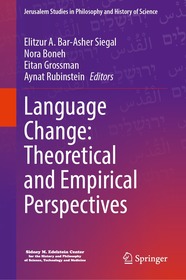
Comparative and Dialectal Approaches to Analogy
Inflection in Romance and Beyond
Series: Oxford Studies in Diachronic and Historical Linguistics; 55;
- Publisher's listprice GBP 99.00
-
47 297 Ft (45 045 Ft + 5% VAT)
The price is estimated because at the time of ordering we do not know what conversion rates will apply to HUF / product currency when the book arrives. In case HUF is weaker, the price increases slightly, in case HUF is stronger, the price goes lower slightly.
- Discount 10% (cc. 4 730 Ft off)
- Discounted price 42 568 Ft (40 541 Ft + 5% VAT)
Subcribe now and take benefit of a favourable price.
Subscribe
47 297 Ft

Availability
Estimated delivery time: In stock at the publisher, but not at Prospero's office. Delivery time approx. 3-5 weeks.
Not in stock at Prospero.
Why don't you give exact delivery time?
Delivery time is estimated on our previous experiences. We give estimations only, because we order from outside Hungary, and the delivery time mainly depends on how quickly the publisher supplies the book. Faster or slower deliveries both happen, but we do our best to supply as quickly as possible.
Product details:
- Publisher OUP Oxford
- Date of Publication 30 September 2025
- ISBN 9780198888741
- Binding Hardback
- No. of pages320 pages
- Size 240x165x25 mm
- Weight 625 g
- Language English 700
Categories
Short description:
This book brings together work in inflectional morphology, historical linguistics, and dialectology to explore the processes, directionality, models, and targets of morphological analogy. The chapters draw on atlas data, historical sources, and experimental and computational methods, and present case studies from Romance and Germanic languages.
MoreLong description:
This volume brings together specialists in inflectional morphology, historical linguistics, and dialectology to explore the processes, directionality, models, and targets of morphological analogy. The chapters draw on atlas data and historical sources, as well as experimental and computational methods, and present case studies from a range of Romance and Germanic languages. Existing work on inferential relationships, predictability, and complexity has investigated what information speakers can access with respect to the shape of inflectional forms; the studies presented here examine how speakers make use of that information and shed light on the properties and contours of inflectional structure.
The book is divided into three thematic sections that explore, respectively: the range of objects and patterns that morphological analogy can manipulate; the influence of frequency effects on the choice of models and targets in analogical change; and the mechanisms of change and how these can be modelled. The contributors discuss a variety of significant theoretical issues including the advantages of different models of analogy and inflection, constraints on the choice of template for analogy, autonomous morphology, and non-canonical inflection and morphological complexity. The historical, variationist approaches taken here will complement the considerable existing body of theoretical work in this field and will be of interest to scholars and advanced students working on language change, language complexity, and word structure.
Table of Contents:
Introduction: Studying variation and change in inflectional analogy
PART I Inflectional patterns and their interaction
Contamination as a cause of abnormal inflexion-class changes in 'Alpine' Romance, and what it tells us about word structure
Additive analogy maximizes left-edge identity of roots in Romance
Analogical extension of stress patterns in artificial language learning
PART II Directionality and frequency effects
Modal verbs in Norwegian (and Swedish): Between analogical regularization and analogical irregularization?
The verbs dire 'say' and venire 'come' as 'leader words' in Italo-Romance
Productive identities spanning recurrent partials and whole word forms
PART III Processes and representations of analogy
Morphological analogy as whole-word replacement: Revisiting the counterevidence
Take-over as analogical change in the creation and avoidance of syncretism and homonymy
Overabundance as an epiphenomenon: Competing forms or competing paradigms?
Morphomes, models, emergence, and the mind





